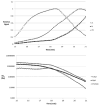Molecular characterization of multivalent bioconjugates by size-exclusion chromatography with multiangle laser light scattering
- PMID: 22794081
- PMCID: PMC3900495
- DOI: 10.1021/bc3000595
Molecular characterization of multivalent bioconjugates by size-exclusion chromatography with multiangle laser light scattering
Abstract
The degree of substitution and valency of bioconjugate reaction products are often poorly judged or require multiple time- and product-consuming chemical characterization methods. These aspects become critical when analyzing and optimizing the potency of costly polyvalent bioactive conjugates. In this study, size-exclusion chromatography with multiangle laser light scattering was paired with refractive index detection and ultraviolet spectroscopy (SEC-MALS-RI-UV) to characterize the reaction efficiency, degree of substitution, and valency of the products of conjugation of either peptides or proteins to a biopolymer scaffold, i.e., hyaluronic acid (HyA). Molecular characterization was more complete compared to estimates from a protein quantification assay, and exploitation of this method led to more accurate deduction of the molecular structures of polymer bioconjugates. Information obtained using this technique can improve macromolecular engineering design principles and help to better understand multivalent macromolecular interactions in biological systems.
Figures








Similar articles
-
Multivalent hyaluronic acid bioconjugates improve sFlt-1 activity in vitro.Biomaterials. 2016 Jul;93:95-105. doi: 10.1016/j.biomaterials.2016.03.017. Epub 2016 Mar 12. Biomaterials. 2016. PMID: 27086270 Free PMC article.
-
Branching Analysis of Multivalent Conjugates Using Size Exclusion Chromatography-Multiangle Light Scattering.Biomacromolecules. 2016 Oct 10;17(10):3162-3171. doi: 10.1021/acs.biomac.6b00785. Epub 2016 Sep 12. Biomacromolecules. 2016. PMID: 27548567
-
[Evaluation of molecular weights of hyaluronate preparations by multi-angle laser light scattering].Kokuritsu Iyakuhin Shokuhin Eisei Kenkyusho Hokoku. 2003;(121):30-3. Kokuritsu Iyakuhin Shokuhin Eisei Kenkyusho Hokoku. 2003. PMID: 14740402 Japanese.
-
Using light scattering to determine the stoichiometry of protein complexes.Methods Mol Biol. 2004;261:113-8. doi: 10.1385/1-59259-762-9:113. Methods Mol Biol. 2004. PMID: 15064452 Review.
-
Flow field-flow fractionation and multiangle light scattering for ultrahigh molecular weight sodium hyaluronate characterization.J Sep Sci. 2010 Nov;33(22):3519-29. doi: 10.1002/jssc.201000414. Epub 2010 Sep 30. J Sep Sci. 2010. PMID: 20886518 Review.
Cited by
-
Multivalent conjugates of basic fibroblast growth factor enhance in vitro proliferation and migration of endothelial cells.Biomater Sci. 2018 May 1;6(5):1076-1083. doi: 10.1039/c7bm01052d. Biomater Sci. 2018. PMID: 29595848 Free PMC article.
-
Clearance Kinetics and Clearance Routes of Molecules From the Suprachoroidal Space After Microneedle Injection.Invest Ophthalmol Vis Sci. 2017 Jan 1;58(1):545-554. doi: 10.1167/iovs.16-20679. Invest Ophthalmol Vis Sci. 2017. PMID: 28125841 Free PMC article.
-
Conformational flexibility of EptA driven by an interdomain helix provides insights for enzyme-substrate recognition.IUCrJ. 2021 Jul 15;8(Pt 5):732-746. doi: 10.1107/S2052252521005613. eCollection 2021 Sep 1. IUCrJ. 2021. PMID: 34584735 Free PMC article.
-
Biopolymer Molecular Weight Can Modulate the Wound Healing Efficacy of Multivalent Sonic Hedgehog-Hyaluronic Acid Conjugates.Biomacromolecules. 2017 Aug 14;18(8):2350-2359. doi: 10.1021/acs.biomac.7b00553. Epub 2017 Jul 21. Biomacromolecules. 2017. PMID: 28679037 Free PMC article.
-
Multivalent Conjugates of Sonic Hedgehog Accelerate Diabetic Wound Healing.Tissue Eng Part A. 2015 Sep;21(17-18):2366-78. doi: 10.1089/ten.TEA.2014.0281. Tissue Eng Part A. 2015. PMID: 26154888 Free PMC article.
References
-
- Elbert D, Hubbell J. Conjugate addition reactions combined with free-radical cross-linking for the design of materials for tissue engineering. Biomacromolecules. 2001;2:430–441. - PubMed
-
- Wall ST, Saha K, Ashton RS, Kam KR, Schaffer DV, Healy KE. Multivalency of Sonic hedgehog conjugated to linear polymer chains modulates protein potency. Bioconjug Chem. 2008;19:806–12. - PubMed
-
- Drumheller P, Elbert D, Hubbell J. Multifunctional poly (ethylene glycol) semi-interpenetrating polymer networks as highly selective adhesive substrates for bioadhesive peptide grafting. Biotechnology and bioengineering. 1994;43:772–780. - PubMed
-
- Stile RA, Healy KE. Thermo-responsive peptide-modified hydrogels for tissue regeneration. Biomacromolecules. 2001;2:185–94. - PubMed
-
- Ho M, Wang D, Hsieh H, Liu H, Hsien T, Lai J, Hou L. Preparation and characterization of RGD-immobilized chitosan scaffolds. Biomaterials. 2005;26:3197–3206. - PubMed
Publication types
MeSH terms
Substances
Grants and funding
LinkOut - more resources
Full Text Sources

